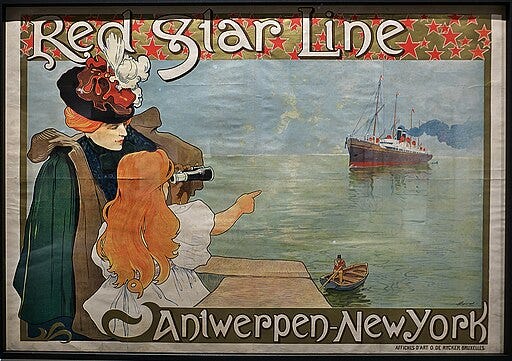One of my go-to hobbies recently is looking up old newspaper articles about Titanic passengers. I try to avoid ones that are about passengers who are commonly referred to in the mainstream Titanic literature (for example, John Jacob Astor, the richest passenger on the Titanic) and instead focus on stories that are less well known.

Recently, I came across the story of a first class Jewish passenger named Jacob Birnbaum, who was originally from Krakow, Austria, which is in today’s Poland. He was a twenty-four year old diamond dealer, which was a common trade of the Jewish culture in the area. He lived in Europe before leaving for America via Antwerp, Belgium.
His story originally stood out to me for a reason that is a bit humorous. I had previously seen a picture of what appears to be a drawing of him in the newspaper after the sinking. To say it as politely as possible, this picture gave him a strange look that looks more like a cartoon than a human. I was reading a book recently about Jewish passengers on the Titanic and came across an actual picture of Birnbaum and I said out loud “that is that guy!” Here was the real image of him, a handsome and intelligent looking individual. I was upset that the more commonly seen biographical picture of Birnbaum does not do him justice.
Birnbaum came to the United States in 1909 and was the head of Jacob Birnbaum & Co. diamond firm. He lived in San Francisco at the time of the Titanic wreck. He was single. An interesting part of his story to me was that he almost missed the Titanic voyage all together as he was going to sail from his European home in Antwerp, Belgium, on a ship of a different company called The Red Star Line located in Antwerp. When he originally came to America in 1909, he travelled on a ship of the Red Star Line called SS Kroonland. Birnbaum was described on the passenger list as 5’6 with brown hair and brown eyes, and his ultimate destination at the time was listed to be Seattle, Washington.
A modern museum and steerage conditions on the Red Star Line
When researching Birnbaum’s story, I was delighted to find that there is a museum still in operation in Antwerp, Belgium, called the Red Star Line Museum that tells the stories of passengers who emigrated from Antwerp on the Red Star Line.

It is noted that many of the passengers of this line were of Jewish heritage like Birnbaum. I was able to find a news article from the Birmingham Evening Mail of Birmingham, England, that described a bit about the plight of the passengers of the Red Star Line that travelled in steerage class.
The article dated May 27, 1904, stated that 700 persons were sailing from England to Antwerp where they would join the Kroonland for New York at a rate of 2 pounds for the crossing. The majority of the passengers were Jewish and included men, women and children. At 2 pounds the ticket would cover food, fare, doctor, services of steward and stewardess, use of bedding, everything. It even stated what a typical menu (noted to have no restrictions to quantities) would look like:
Breakfast: Oatmeal porridge and milk, steak and onions, Irish stew, bread and butter, and coffee.
Dinner: Barley broth, boiled mutton and caper sauce, curry and rice, potatoes, turnips and prunes.
Tea: Pork, pickles, bread and butter, jams and tea.
Supper: Gruel, biscuits, and cheese.
A voyage of refuge on the Red Star Line
It is uncertain what class Birnbaum sailed on his voyage with the Red Star Line in 1909, but given that he was a first class passenger on the Titanic, I would assume he may have sailed in the luxury class. Another passenger of the luxury class, who was noted to make several voyages on the Red Star Line and who has his own exhibit at their museum, is Albert Einstein.
In 1933, Einsten made a return trip from New York to Europe on the Red Star Line ship Belgenland. He found out then that Nazis had plundered his summer house and decided not to proceed to Germany. He was taken in by friendly scientists and artists in Belgium, and in October of that year, he made his voyage of refuge to America on the Red Star Line ship, SS Westerland. According to an article from The Fresno Bee dated October 17, 1933, accompanied by his wife and his assistant, he was whisked aboard a tugboat from the ship. At the dock of New York a line of interviewers and friends of Einstein showed up to greet him.

Einstein exited at the municipal pier and was put into an automobile bound for Princeton, New Jersey. He was noted during his voyage on the Westerland to stay in his stateroom. He did play his violin throughout the voyage, and once he arrived in America he declared he would never set foot in Germany again due to the Nazi policies.
A sad ending for Birnbaum
Unfortunately, Birnbaum did not sail with the Red Star Line as he originally planned for his return trip to America in 1912, and ended up on the doomed maiden voyage of the Titanic. Birnbaum died in the sinking. Unlike many other passengers, his body was found. He was laid to rest in a Jewish cemetery in the Netherlands rather than Belgium due to a law in Belgium that after thirty years the state has the right to remove a tomb. According to Jewish law, the body must rest eternally, so he was buried in the Netherlands where the burial law did not apply.
Birnbaum’s tomb has a picture of a ship on top and reads:
“The educated young man Yaakov Zel, son of Mazo Yeruham Birenboim in Karaka, so many years old, drowned in the wreck of the Titanic on the day of Nisan, twelve days later, his body was found on the sea and he was taken to the cemetery on the day of Shavuot.
Your judgments will be hidden, Rena O'ul, for days in Tir, in the years he went down from the grave to the bar of the refuge of life in the land of Hamshir, in the heights you will find his soul, and he will rest.”
An interesting fact that I learned about in reading about Jewish culture and the Titanic is that there was a rabbi who was involved in the burial of deceased Titanic passengers who for some reason was identifying passengers who were not Jewish as Jewish to be buried in the Jewish cemetery in Halifax, Canada. When the mistake was made known to the families of the non-Jewish passengers, they simply opted to keep their loved ones where they were laid to rest in the Jewish cemetery.
Conclusions
Birnbaum’s story is a sad one and speaks to the risks that individuals were willing to take in order to make the voyage across the ocean and make a better life for themselves and their loved ones. The efforts of the Red Star Line Museum are keeping this story alive, even after so many years. If you would be interested in reading a book that focuses on the Jewish experience of immigration on the ocean liners as well as the Jewish Titanic story, I highly suggest The Jews of the Titanic, A Reflection of the Jewish World on the Epic Disaster by Eli Moskowitz.
Sources:
https://www.findagrave.com/memorial/25573449/jakob-birnbaum
https://en.wikipedia.org/wiki/SS_Westernland
https://www.encyclopedia-titanica.org/titanic-victim/jakob-birnbaum.html
https://redstarline.be/en/story/albert-einstein-famous-passenger
https://redstarline.be/en/content/welcome
The Jews of the Titanic, A Reflection of the Jewish World on the Epic Disaster, Eli Moskowitz, Gefen Publishing, 2018.






A very sad tale. Of course Birnbaum would not have considered the crossing in the Titanic a risky venture. The ship was advertised as unsinkable.
His grave is interesting. I wonder if any other victims have a ship as a design.